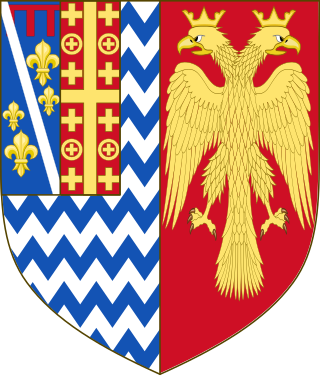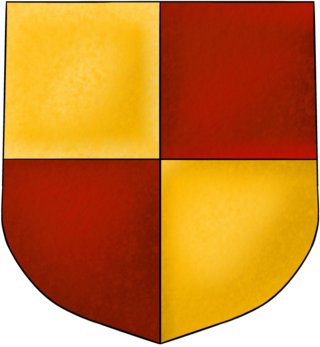
Constantine XI Dragases Palaiologos or DragašPalaeologus was the last Roman (Byzantine) emperor, reigning from 1449 until his death in battle at the Fall of Constantinople in 1453. Constantine's death marked the definitive end of the Eastern Roman Empire, which traced its origin to Constantine the Great's foundation of Constantinople as the Roman Empire's new capital in 330.

The Principality of Achaea or Principality of Morea was one of the vassal states of the Latin Empire, which replaced the Byzantine Empire after the capture of Constantinople during the Fourth Crusade. It became a vassal of the Kingdom of Thessalonica, along with the Duchy of Athens, until Thessalonica was captured by Theodore, the despot of Epirus, in 1224. After this, Achaea became for a while the dominant power in Greece.
The Prince of Achaea was the ruler of the Principality of Achaea, one of the crusader states founded in Greece in the aftermath of the Fourth Crusade (1202–1204). Though more or less autonomous, the principality was never a fully independent state, initially being a vassal state subservient of the Latin Empire of Constantinople, which had supplanted the Byzantine Empire, and later of the Angevin Kingdom of Naples. During the Angevin period, the princes were often absent, being represented in the Principality by their baillis, who governed in their name.

The despot of Epirus was the ruler of the Despotate of Epirus, one of the successor states of the Byzantine Empire in the aftermath of the Fourth Crusade. The name "Despotate of Epirus" and the title "despot of Epirus" are modern historiographical names, and were not in use by the despots themselves. In the Byzantine Empire, the title of despot was a prestigious court title and did not designate rule over some specific territory. Though several of the early Greek rulers of the Epirote realm did use the title of despot, it was never in reference to the lands they governed, but instead in reference to their position in the imperial hierarchy.

Thomas Palaiologos or Palaeologus was Despot of the Morea from 1428 until the fall of the despotate in 1460, although he continued to claim the title until his death five years later. He was the younger brother of Constantine XI Palaiologos, the final Byzantine emperor. Thomas was appointed as Despot of the Morea by his oldest brother, Emperor John VIII Palaiologos, in 1428, joining his two brothers and other despots Theodore and Constantine, already governing the Morea. Though Theodore proved reluctant to cooperate with his brothers, Thomas and Constantine successfully worked to strengthen the despotate and expand its borders. In 1432, Thomas brought the remaining territories of the Latin Principality of Achaea, established during the Fourth Crusade more than two hundred years earlier, into Byzantine hands by marrying Catherine Zaccaria, daughter and heir to the principality.
Carlo I Tocco was the hereditary Count palatine of Cephalonia and Zakynthos from 1376, and ruled as the Despot of Epirus from 1411 until his death on July 4, 1429.

Centurione II Zaccaria, scion of a powerful Genoese merchant family established in the Morea, was installed as Prince of Achaea by Ladislaus of Naples in 1404 and was the last ruler of the Latin Empire not under Byzantine suzerainty.

The Frankokratia, also known as Latinokratia and, for the Venetian domains, Venetokratia or Enetokratia, was the period in Greek history after the Fourth Crusade (1204), when a number of primarily French and Italian states were established by the Partitio terrarum imperii Romaniae on the territory of the dissolved Byzantine Empire.

Chlemoutsi, also known as Clermont, is a medieval castle in the northwest of the Elis regional unit in the Peloponnese peninsula of southern Greece, in the Kastro-Kyllini municipality.

Glarentza, also known as or Clarenia, Clarence, or Chiarenza, was a medieval town located near the site of modern Kyllini in Elis, at the westernmost point of the Peloponnese peninsula in southern Greece. Founded in the mid-13th century by William II of Villehardouin, the town served as the main port and mint of the Frankish Principality of Achaea, being located next to the Principality's capital, Andravida. Commerce with Italy brought great prosperity, but the town began to decline in the early 15th century as the Principality itself declined. In 1428, Glarentza was ceded to the Byzantine Despotate of the Morea, and served as its co-capital, being the residence of one of the Palaiologos despots, until the Ottoman conquest in 1460. Under Ottoman rule, Glarentza declined rapidly as the commercial links with Italy were broken, and by the 16th century was abandoned and falling into ruin. Little remains of the town today: traces of the city wall, of a church and a few other buildings, as well as the silted-up harbour.

The Morea revolt of 1453–1454 was a failed peasant rebellion carried out against the rule of the brothers Thomas and Demetrios Palaiologos, rulers of the Byzantine Despotate of the Morea in the Peloponnese peninsula.

Helena Palaiologina was a Byzantine princess who married Serbian Despot Lazar Branković, who ruled from 1456 until his death in 1458. After Smederevo fell to the Ottoman Turks on 20 June 1459, she fled Serbia for the Greek island of Leukas, where she converted to Catholicism.

The House of Tocco was an Italian noble family from Benevento that came to prominence in the late 14th and 15th centuries, when they ruled various territories in western Greece as Counts Palatine of Cephalonia and Zakynthos and Despots of Epirus. During their brief period of rule in Greece, they were one of the most ambitious and able Latin dynasties in the region, and they were one of the few to leave descendants lasting until modern times.
Leonardo II Tocco was a scion of the Tocco family and lord of Zakynthos, who played an important role as a military leader for his brother, Carlo I Tocco, in early 15th-century western Greece.

The Barony of Arcadia was a medieval Frankish fiefdom of the Principality of Achaea, located on the western coast of the Peloponnese peninsula in Greece, and centred on the town of Arcadia, ancient and modern Kyparissia.

The Barony of Chalandritsa was a medieval Frankish fiefdom of the Principality of Achaea, located in the northern Peloponnese peninsula in Greece, and centred on the town of Chalandritsa south of Patras.

The Barony of Estamira or Stamira was a medieval Frankish fiefdom of the Principality of Achaea, located in the fertile plains of the Elis region of the Peloponnese peninsula in Greece, and centred on the now vanished fortress of Estamira.
Stephen Zaccaria was the youngest brother of the last Prince of Achaea, Centurione II Zaccaria, and Latin Archbishop of Patras from 1404 until his death in 1424.
Don Antonio Tocco was the last titular Despot of Epirus and Count Palatine of Cephalonia and Zakynthos, claiming these titles from the death of his father Leonardo V Tocco in 1641 until he abandoned them in 1642, substituting them for the title of Prince of Achaea, which he used until his death in 1678.
The Ottoman conquest of the Morea occurred in two phases, in 1458 and 1460, and marked the end of the Despotate of the Morea, one of the last remnants of the Byzantine Empire, which had been extinguished in the Fall of Constantinople in 1453.












